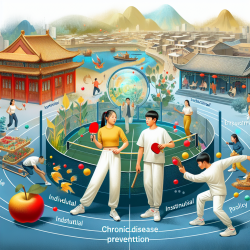Introduction
As a practitioner focused on improving outcomes for children, it's crucial to integrate data-driven approaches into your practice. The research article "Physical activity and prevention of chronic disease in Chinese youth: A public health approach" provides valuable insights that can enhance your skills and encourage further research. This blog will explore the key findings and implications of this study, offering practical steps to incorporate these insights into your practice.
Understanding the Problem
The study highlights a concerning trend: a decline in physical activity (PA) among Chinese youth, which poses significant health risks. Despite the known benefits of regular PA, only a small percentage of children meet the recommended 60 minutes of moderate-to-vigorous physical activity (MVPA) daily. This inactivity is linked to increased rates of obesity and chronic diseases.
Adopting a Social-Ecological Perspective
The research suggests that current PA promotion policies are limited in their effectiveness. A shift to a social-ecological model is recommended, which considers multiple levels of influence on PA behaviors. This model emphasizes the role of:
- Intra-individual factors (e.g., motivation, knowledge)
- Inter-individual factors (e.g., family, peers)
- Organizational factors (e.g., schools, sports clubs)
- Community factors (e.g., neighborhood safety, facilities)
- Public policy (e.g., national health initiatives)
By understanding these influences, practitioners can develop more effective, culturally appropriate interventions.
Implementing Effective Interventions
To enhance PA among Chinese youth, interventions must be theoretically guided and culturally tailored. Practitioners should consider the following strategies:
- Developing school-based programs that integrate PA into the daily curriculum.
- Engaging families and communities in promoting active lifestyles.
- Advocating for policies that create supportive environments for PA.
- Utilizing technology to track and encourage PA among youth.
Encouraging Further Research
The study underscores the need for empirical research to validate the social-ecological model in the context of Chinese youth. Practitioners are encouraged to contribute to this body of research by:
- Collaborating with researchers to design and test interventions.
- Sharing data and insights from their practice to inform policy development.
- Participating in professional development opportunities focused on PA promotion.
Conclusion
By adopting a public health approach informed by the social-ecological model, practitioners can play a pivotal role in reversing the trend of declining PA among Chinese youth. This approach not only supports the goals of Healthy China 2030 but also contributes to the prevention of chronic diseases. For a deeper understanding of the research, practitioners are encouraged to read the original article.
To read the original research paper, please follow this link: Physical activity and prevention of chronic disease in Chinese youth: A public health approach.










